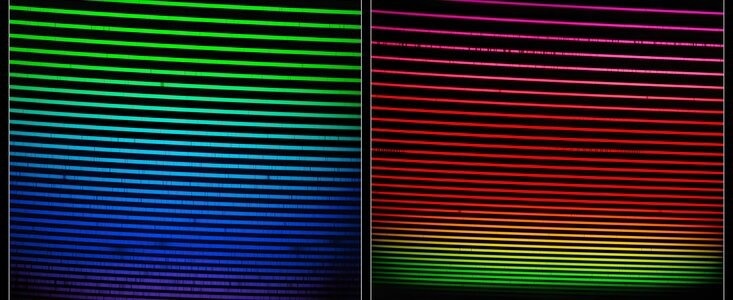Gemini South, one of the most productive and strong optical-infrared telescopes in the world, has received a significant ability boost with the successful installation of a new high-resolution spectrograph known as GHOST fabricated by an international consortium.
 The two GHOST spectra. Image Credit: National Science Foundation.
The two GHOST spectra. Image Credit: National Science Foundation.
This state-of-the-art scientific instrument will extend the knowledge of the earliest stars, the chemical fingerprints of distant planetary systems, and the development and progress of galaxies. Gemini South in Chile is considered one-half of the International Gemini Observatory, that have been operated by NSF’s NOIRLab.
GHOST (Gemini High-resolution Optical SpecTrograph), Gemini South's newest science instrument, achieved first light by making elegant observations of HD 222925, an unusually bright and chemically complicated star located over 1400 light-years away in the direction of the southern hemisphere constellation Tucana.
This star is known as a prime example of the type of object that GHOST will examine. Gemini South is one-half of the International Gemini Observatory.
This is an exciting milestone for astronomers around the globe who rely on Gemini South to study the Universe from this exceptional vantage point in Chile. Once this next-generation instrument is commissioned, GHOST will be an essential component of the astronomers toolbox.
Jennifer Lotz, Director, Gemini Observatory
One of the most crucial scientific tools in all of astronomy is the spectrograph. Spectrographs accurately assess the spectrum of light released by these objects, disclosing detailed information about their chemical composition, motion, and ancient counterparts at the edge of the observable Universe, in contrast to high-resolution cameras that capture incredible details of distant stars and galaxies.
GHOST is by far the most sensitive high-resolution spectrograph across the full optical wavelength range of any of the spectrographs presently in use on comparably-sized telescopes, with ten times the spectral resolution of GMOS, Gemini’s other major optical spectrograph.
Additionally, GHOST will offer crucial follow-up observations of significant targets discovered by numerous current and upcoming surveys, including SkyMapper, GAIA, and the Legacy Survey of Space and Time at the Vera C. Rubin Observatory.
The tool is open-access, so any researcher with a strong scientific justification can submit proposals to use it in their work. Astronomers using the instrument will have access to a data reduction pipeline through NOIRLab.
The Herzberg Astronomy and Astrophysics Research Centre of the National Research Council of Canada (NRC), which was in charge of building the spectrograph, and the Australian National University (ANU), which is in charge of the instrument control system and data reduction software, make up the GHOST team, which is led by Australian Astronomical Optics (AAO) at Macquarie University.
The design and construction of GHOST started back in 2010 and took nearly a decade to be completed. The instrument was given to Gemini South in early 2020, even though COVID-19 restrictions meant that installation by the teams from Australia and Canada had to wait until early 2022.
With its successful installation and first-light observations, the commissioning group put GHOST through its paces to clarify if its systems were performing as intended. As soon as the commissioning process is complete, it will unite Gemini South’s various suites of progressed optical and infrared instruments and be provided to astronomers to use.
The installation and commissioning have been a long time coming, but the team has been working efficiently and quickly. It was a really special day when we saw our first rainbow from the instrument.
Steve Margheim, GHOST Project Scientist, NOIRLab, National Science Foundation
“With the successful commissioning of GHOST, NSF congratulates the instrument team on delivering to the international astronomy community enhanced capability to explore planets, stars, and galaxies. We eagerly await the new discoveries,” stated Martin Still, Gemini Program Officer at the National Science Foundation.
It is anticipated that GHOST will be made available to the astronomical community in the first half of 2023.